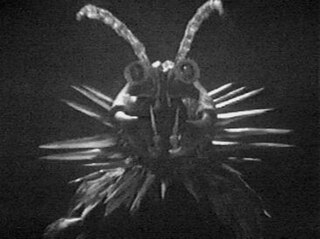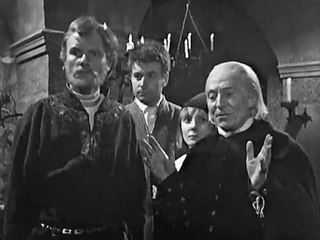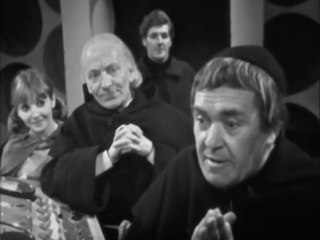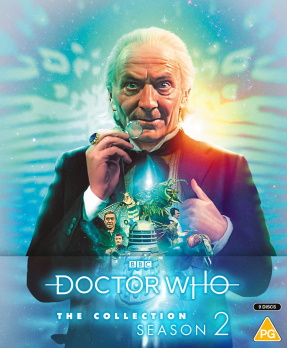
An Unearthly Child is the first serial of the British science fiction television series Doctor Who. It was first broadcast on BBC TV in four weekly parts from 23 November to 14 December 1963. Scripted by Australian writer Anthony Coburn, the serial introduces William Hartnell as the First Doctor and his original companions: Carole Ann Ford as the Doctor's granddaughter, Susan Foreman, with Jacqueline Hill and William Russell as school teachers Barbara Wright and Ian Chesterton. The first episode deals with Ian and Barbara's discovery of the Doctor and his time-space ship, the TARDIS, in a junkyard in contemporary London. The remaining episodes are set amid a power struggle between warring Stone Age factions who have lost the secret of making fire.

The Daleks is the second serial in the British science fiction television series Doctor Who, which was first broadcast on BBC TV in seven weekly parts from 21 December 1963 to 1 February 1964. Written by Terry Nation and directed by Christopher Barry and Richard Martin, this story marks the first appearance of the show's most popular villains, the Daleks, and the recurring Skaro people, the Thals. In the serial, the First Doctor, his granddaughter Susan Foreman, and her teachers Ian Chesterton and Barbara Wright land in an alien jungle and are captured by the Daleks, a race of mutated creatures who survive off the radiation that remains in the atmosphere after a nuclear war with their enemies. As the group attempt to escape the Daleks, they discover more about the planet and the ensuing war, and attempt to broker a peace.

Marco Polo is the fourth serial of the British science fiction television series Doctor Who. It was first broadcast on BBC TV in seven weekly parts from 22 February to 4 April 1964. It was written by John Lucarotti and directed largely by Waris Hussein; John Crockett directed the fourth episode. The story is set in Yuan-era China in the year 1289, where the Doctor, his granddaughter Susan Foreman, and her teachers Ian Chesterton and Barbara Wright meet the Italian merchant-explorer Marco Polo and Mongolian Emperor Kublai Khan.

The Keys of Marinus is the fifth serial in the British science fiction television series Doctor Who, which was first broadcast on BBC TV/BBC1 in six weekly parts from 11 April to 16 May 1964. Written by Terry Nation and directed by John Gorrie, the serial takes on a "mini-adventures" format, in which the First Doctor, his granddaughter Susan Foreman, and her teachers Ian Chesterton, and Barbara Wright search for four keys to restore the Conscience of Marinus, a computer which maintains law and order. The group travel to two cities, a jungle, and an icy wasteland in search of the keys.

The Aztecs is the sixth serial in the British science fiction television series Doctor Who, which was first broadcast on BBC1 in four weekly parts from 23 May to 13 June 1964. It was written by John Lucarotti and directed by John Crockett. In the serial, the First Doctor, his granddaughter Susan, and teachers Ian Chesterton and Barbara Wright arrive in Mexico during the Aztec empire. Barbara becomes mistaken for the goddess Yetaxa, and accepts the identity in hope of persuading the Aztecs to give up human sacrifice, despite the Doctor's warnings about changing history.

Barbara Wright is a fictional character in the British science fiction television series Doctor Who and a companion of the First Doctor. She was one of the programme's first regulars and appeared in the bulk of its first two seasons from 1963 to 1965, played by Jacqueline Hill. Prior to Hill being cast the part had originally been offered to actress Penelope Lee, who turned the role down. Barbara appeared in 16 stories. In the film version of one of the serials, Dr. Who and the Daleks (1965), Barbara was played by actress Jennie Linden, but with a very different personality and backstory, which includes her being a granddaughter of "Dr Who".

The Dalek Invasion of Earth is the second serial of the second season in the British science fiction television series Doctor Who. Written by Terry Nation and directed by Richard Martin, the serial was broadcast on BBC1 in six weekly parts from 21 November to 26 December 1964. In the serial, the First Doctor, his granddaughter Susan Foreman, and teachers Ian Chesterton and Barbara Wright discover that the Earth in the 22nd century has been occupied by Daleks. They work with a human resistance group to stop the Daleks from mining out the Earth's core as part of their plan to pilot the planet through space.

The Sensorites is the seventh serial in the British science fiction television series Doctor Who. Written by Peter R. Newman and directed by Mervyn Pinfield and Frank Cox, the serial was first broadcast on BBC1 in six weekly parts from 20 June to 1 August 1964. In the serial, the First Doctor, his granddaughter Susan Foreman, and her teachers Ian Chesterton and Barbara Wright visit a planet known as the Sense-Sphere to find the cure to a disease afflicting the alien race the Sensorites.

The Web Planet is the fifth serial of the second season in the British science fiction television series Doctor Who. Written by Bill Strutton and directed by Richard Martin, the serial was broadcast on BBC1 in six weekly parts from 13 February to 20 March 1965. In the serial, the First Doctor and his travelling companions Ian Chesterton, Barbara Wright, and Vicki ally themselves with the Menoptra, the former inhabitants of the planet Vortis, as they struggle to win back the planet from the malignant Animus and its Zarbi slaves.

The Reign of Terror is the eighth serial in the British science fiction television series Doctor Who, which was first broadcast on BBC1 in six weekly parts from 8 August to 12 September 1964. It was written by Dennis Spooner and directed by Henric Hirsch. In the serial, the First Doctor, his granddaughter Susan, and teachers Ian Chesterton and Barbara Wright arrive in France during the period of the French Revolution known as the Reign of Terror, where they become involved with prisoners and English spies.

Planet of Giants is the first serial of the second season in the British science fiction television series Doctor Who. Written by Louis Marks and directed by Mervyn Pinfield and Douglas Camfield, the serial was first broadcast on BBC1 in three weekly parts from 31 October to 14 November 1964. In the serial, the First Doctor, his granddaughter Susan Foreman, and her teachers Ian Chesterton and Barbara Wright are shrunk to the size of an inch after the Doctor's time machine the TARDIS arrives in contemporary England.

The Rescue is the third serial of the second season of the British science fiction television series Doctor Who. Written by outgoing story editor David Whitaker and directed by Christopher Barry, the serial was broadcast on BBC1 in two weekly parts on 2 January and 9 January 1965. In the serial, the time travellers the First Doctor, Ian Chesterton, and Barbara Wright befriend Vicki, an orphan girl marooned on the planet Dido who is being threatened by an apparent native of Dido called Koquillion while awaiting rescue.

The Romans is the fourth serial of the second season in the British science fiction television series Doctor Who. Written by Dennis Spooner and directed by Christopher Barry, the serial was broadcast on BBC1 in four weekly parts from 16 January to 6 February 1965. In the serial, the First Doctor and his new companion Vicki investigate intrigue surrounding the death of a lyre player en route to perform at the palace of Nero in Rome, while companion Ian Chesterton travels to Nero's palace to save his fellow schoolteacher Barbara Wright, who had been sold to Nero's wife Poppaea as a slave.

The Crusade is the sixth serial of the second season in the British science fiction television series Doctor Who. Written by David Whitaker and directed by Douglas Camfield, the serial was broadcast on BBC1 in four weekly parts from 27 March to 17 April 1965. In this serial, the First Doctor and his travelling companions Ian Chesterton, Barbara Wright, and Vicki arrive in 12th century Palestine during the Third Crusade, and find themselves entangled in the conflict between King Richard the Lionheart and Saladin. They also meet King Richard's sister Lady Joanna and Saladin's brother Saphadin.

The Space Museum is the seventh serial of the second season in the British science fiction television series Doctor Who. Written by Glyn Jones and directed by Mervyn Pinfield, it was broadcast on BBC1 in four weekly parts from 24 April to 15 May 1965. In the serial, the First Doctor and his travelling companions Ian Chesterton, Barbara Wright, and Vicki arrive in a Space Museum on the planet Xeros, where they seek to change their fate after seeing themselves turned into museum exhibits in the future. They also become entangled in a conflict between the militaristic Moroks who run the museum, and the servile indigenous Xerons who work for them.

The Chase is the eighth serial of the second season in the British science fiction television series Doctor Who. Written by Terry Nation and directed by Richard Martin, the serial was broadcast on BBC in six weekly parts from 22 May to 26 June 1965. Set in multiple time periods on several different planets, including Aridius, Earth, and Mechanus, the serial features the Dalek race travelling through time while pursuing the time machine the TARDIS and its occupants—the First Doctor and his companions Ian Chesterton, Barbara Wright, and Vicki —to kill them and seize the TARDIS for themselves. The Doctor and companions encounter several characters, including monsters Dracula and Frankenstein's monster, human astronaut Steven Taylor, and an android replica of the Doctor.

The Time Meddler is the ninth and final serial of the second season of the British science fiction television series Doctor Who. Written by Dennis Spooner and directed by Douglas Camfield, the serial was broadcast on BBC1 in four weekly parts from 3 to 24 July 1965. Set in Northumbria in 1066, before the Battle of Stamford Bridge, the serial features the time traveller the First Doctor and his companions Vicki and Steven Taylor as they attempt to outwit the time traveller the Monk, who is plotting to change the course of European history by wiping out King Harald Hardrada's Viking invasion fleet, leaving Harold Godwinson and the Saxon soldiers fresh to defeat William of Normandy and the Norman soldiers at the Battle of Hastings.

The First Doctor is the original incarnation of the Doctor, the protagonist of the BBC science fiction television series Doctor Who. He was portrayed by actor William Hartnell.

The second season of British science fiction television series Doctor Who was originally broadcast on BBC1 between 1964 and 1965. The season began on 31 October 1964 with Planet of Giants and ended with The Time Meddler on 24 July 1965. Like the first season, production was overseen by the BBC's first female producer Verity Lambert. Story editor David Whitaker continued to handle the scripts and stories during early production, handing over to Dennis Spooner as the season began to air; Spooner subsequently left his role by the season's end, and was replaced by Donald Tosh for its final serial. By the season's end, Lambert was the only remaining production member from the team responsible for creating the series.

The first season of British science fiction television programme Doctor Who was originally broadcast on BBC TV between 1963 and 1964. The series began on 23 November 1963 with An Unearthly Child and ended with The Reign of Terror on 12 September 1964. The show was created by BBC Television head of drama Sydney Newman to fill the Saturday evening timeslot and appeal to both the younger and older audiences of the neighbouring programmes. Formatting of the programme was handled by Newman, head of serials Donald Wilson, writer C. E. Webber, and producer Rex Tucker. Production was overseen by the BBC's first female producer Verity Lambert and story editor David Whitaker, both of whom handled the scripts and stories.





















